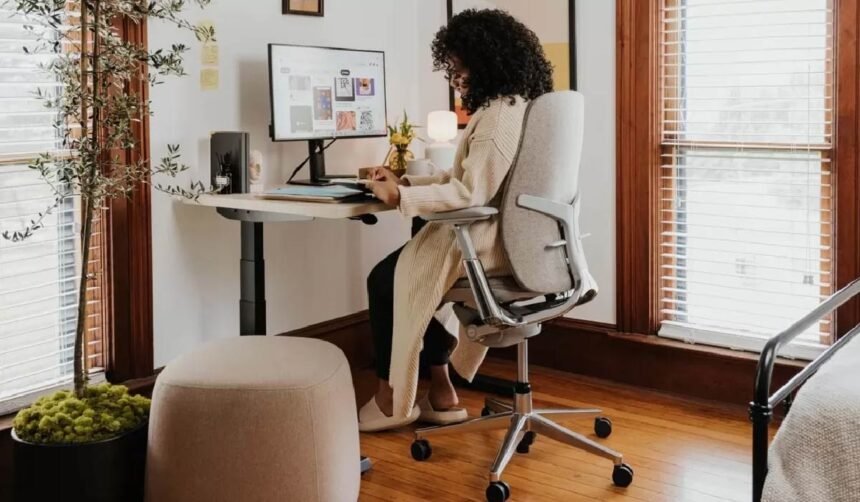Most of the technical professionals today work with code, dashboards, video calls, and a never-ending number of tabs – and they do these most of the time simultaneously. It is switching back and forth on a single screen that consumes time and mental energy. Every key task gets its own space with a dual monitor setup which is a simple solution: code on one screen, documentation, or communication tools on the other. When you have a good quality dual monitor stand, both your screens will always be at the right height and angle, thus you will be able to free up some valuable desk space and your neck and eyes will be less strained.
How a Sit-Stand Desk Changes the Way You Work
Every adjustment, even if it’s just a handful of times a day, is a small injection of movement. Changing to standing from sitting helps circulation, activates the muscles that have become lethargic, and quite often it results in you getting more energy naturally without having to take another coffee. Making calls while standing and quickly going through the work and then lowering the desk for concentrated writing, is the way the cycle works, which is more like a flow than a grind.
If it is to be successful in reality, the tech must fade into the background. That’s why an electric sit stand desk with smooth height changes, solid stability, and memory presets is so useful: you tap a button, the desk moves quietly, and your work continues without a pause. Rather than being one more distracting gadget, it turns out to be a dependable instrument that silently helps your way of thinking, your concentration, and your flow of working during the day.
Building Healthier Work Habits Around a Sit-Stand Desk
Basically, a sit-stand desk is truly effective when it is incorporated into a personal daily routine in a straightforward way. A convenient approach could be to use a desk in the sitting position in the morning for deep focus: making a plan for the day, replying to important emails, and handling work that requires quiet concentration. Late morning or early afternoon, you raise the desk for calls and quick check-ins – work that naturally suits a more open, upright posture. When the familiar post-lunch dip arrives, another height change helps your body and brain reset instead of sliding into autopilot.
Changing positions like that will have a much bigger effect if you also link them to small, frequently repeated rituals. For example, every time you switch your level, you can stretch your shoulders, drink a glass of water, or take a brief glance out the window to rest your eyes. Not one of these things needs a gym membership or a lengthy break; it is just utilizing the natural breaks in your day to make a slight movement and have a reset. A few micro-ritual ideas:
- Stand for calls and roll your shoulders before you hit “join”.
- Lower the desk after lunch and take 10 slow breaths before diving back in.
- Each time you change position, sip water instead of reaching for another coffee.
- Look away from the screen and focus on something distant for 20 seconds.
- Do a quick calf or hamstring stretch while the desk is in motion.
Over time, this kind of routine doesn’t just protect your back and neck. It reduces the build-up of tension that usually crashes into your evening. You finish the day with more energy left for dinner out, a training session, or time with family – not just the sofa and a screen.
Focus, Creativity, and the Psychology of Standing Up
Posture doesn’t just change how your body feels – it also shifts how your brain works. Mostly, fast and active types of work can benefit from standing. For example, making quick decisions, doing live calls, solving problems and brainstorming. Being a standing person, you automatically feel more “on”, use more of your hand gestures, and are less chance of coming into scrolling. A chair is more suitable for lengthy, detailed kind of work such as writing, analysis, and planning that requires an extensive focus on one idea.
A height-adjustable desk makes it easy to move between these two modes. Raising the desk can be your signal for “active mode”; lowering it can mark the start of deep-focus time.
Choosing a Sit-Stand Desk That Matches Your Lifestyle
Different height-adjustable desks do not function the same, and the variations make a significant difference if you are concerned about your comfort and the appearance of the desk. Stability is the first thing that comes to mind: the frame should not wobble, even at the maximum height with one or two large monitors placed on it. The height range also matters a lot, particularly if you are tall, short, or sharing the desk with another person. Each person must be able to sit and stand in a comfortable position. The quiet operation of the movement is, therefore, another great advantage, as a smooth, low noise allows you to change your position without interrupting yourself or others.
Besides performance, design should fit your space, not clash with it – choose a desk size, color, and finish that match your room.


